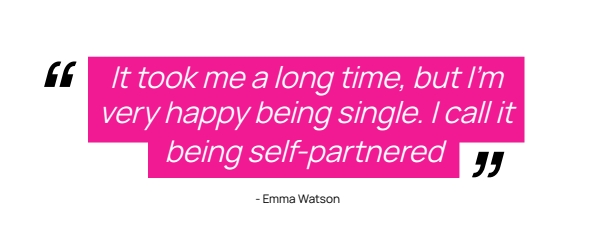Given that there are no fewer than 19 million single adults in the UK today, the fact that this demographic sees marketing and advertising as notably out of step with the feelings and aspirations of single people should come as cause for concern to brands.
A brand new report called ‘Singled Out’, based on 2022 in-depth research by Hotwire Global, is set to give marketing departments a lot more food for thought. The majority of people in the study are consciously choosing to remain single and focus on other priorities over finding a relationship. The ‘Undependents’ – the single consumer cohort – are redefining what it means to be single and what we should all be thinking about it.
This demographic today is unapologetically single, fulfilled, and very happy with their lifestyle choice.
Yet the fact is that they don’t feel like they’re being properly understood by brands, or communicated to in a relevant and resonant way. Two-thirds of study respondents struggled to name a brand which they felt understands single people. Which means that businesses of all kinds are missing a huge trick. Put bluntly, brands should be doing much better in how they talk to single people.
And in case there’s any doubt – they should be talking to single people. This large group (which straddles ages and lifestyles) has disposable income to burn and is very clear about where, when and how they like to spend it.

The new normals
‘It is a truth universally acknowledged, that a single man in possession of a good fortune, must be in want of a wife.’
The opening line from Jane Austen’s Pride and Prejudice is so stylishly seductive and so well-known that it’s easy to see it as a universal truth for the ages. But in actual fact, it seems that it doesn’t hold true in 21st Century Europe. Regardless of gender or sexual orientation (or for that matter the size of one’s “good fortune”), people today are shaking off the received wisdom that aiming for marriage or long-term partnership is the abiding goal in society.
‘Single’ today has a new meaning, one that is multi-faceted and fluid. There are a myriad of different reasons for people to be single, and single people live their lives in many different ways – so in today’s world, a person shouldn’t be defined by their relationship status and the word ‘single’ shouldn’t come with pejorative undertones.
Despite the diversity of people within this demographic, the top three life priorities for single people today are, as uncovered by the report, very clearly defined and agreed: financial security, keeping healthy, and being fit and active.
While there’s surprising unanimity among this wide and various group in how they feel about things, it does seem that age is a factor in increased dissatisfaction with media representation: in other words, the older people get, the more they feel brands don’t understand single people. Over 45s are the segment most likely to feel there are no positive stories about single people like them – 90% say they see very few such stories in adverts or the mass media.
The report gives a thoughtfully rounded picture of why positively choosing to stay single is increasingly attractive. It also usefully identifies the top 10 categories single people spend more on. The top three of these are: eating out; home (i.e. furnishings, accessories); travelling and experiences. And indeed the focus on ‘experiences’ is one that brands across the board would do well to heed, while keeping front of mind that “singles” are not one homogenous group but a diverse range of different people at different ages and life stages with different priorities.
Singles are multi-faceted, so not only should brands be recognising that they need to do more to resonate and connect with single people, but they need their approach to reflect the different wants and needs of different subgroups.
The top concerns and anxieties reported by single people don’t necessarily map onto those identified by married people or those in longer-term relationships. Traditional assumptions don’t hold true: independent doesn’t mean individualistic, self-sufficient doesn’t mean selfish. Dealing with personal finance management is a key concern shared by all regardless of age, gender or class. Single women are less comfortable travelling on their own, while many single men report feeling less comfortable having to deal with furnishing and equipping a home on their own. Planning for retirement is a stronger area of concern for single women than for single men.
There are plenty of similar insights in the report which give a fascinating snapshot the single mindset – and the single consumer landscape – today. Single is not a lifestage – it’s a growing demographic across all age groups, and the report points the way to specific areas where marketing could be doing much better to help.

Unlocking inspiration
Hotwire’s report contains surprising and thought-provoking insights about the single demographic, which deserves to encourage a rethink of communication strategies. It shares inspiration around why being single is increasingly popular, how singles view financial independence, what their main concerns are today, and what they like to spend more money on. But more than that, it uncovers exactly why being single should no longer be seen as a ‘stepping stone’ to something else, but a proudly defining attribute of its own.
